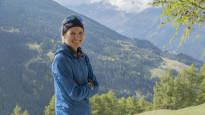A group of athletes is sprinting towards a wall-like steep ski slope. The movement looks like running, but the women have skis on their feet. The mountainside is climbed with a kilometer pole – this sport requires extreme oxygen uptake capacity, muscle endurance and perseverance.
The first woman to finish is Austrian Sarah Dreier, who covered a distance of 2.2 kilometers in just under 24 minutes. No less than 600 meters of ascent were accumulated – the real steepness of the slope cannot be seen in the TV pictures, but the reactions of the women in steely condition at the finish show that it was tough.
This is mountain skiing, or to be more precise, one of its forms of competition, the uphill race. Finnish representation was also seen in Schlaming, Austria, when Susanna Saapunki finished 12th in the grueling race.
Saapunki is a former national team skier, but according to him, mountain skiing has little to do with cross-country skiing. One and a half meter skis are a shorter and lighter version of alpine skiing. They have removable grip soles, thanks to which steep climbing angles are possible.
The technique of the sport is more similar to running on skis than to traditional shift skiing.
– It has actually been extremely challenging to get the shift skiing technique of traditional skiing out of the spine. There is no effort in the same way as in shift skiing, but the work is done on the hips, says Saapunki.
Mountain skiing supports a mountain running career
Alpine skiing, also known as ski mountaineering and ski mountaineering, consists of three very different types of individual competitions. In a traditional individual competition, there are more ups and downs. There are sections in the race where the skis are taken off and attached to the backpack, and progress is continued by running.
– In a way, it’s like a ski race, but everything happens in the mountains. Sometimes we go on a ski slope and sometimes on untouched forest patches and mountain slopes. Sometimes you have to take off your skis. We’ll go downhill on those mini skis, Saapunki says.
Another form of competition, the sprint competition, typically lasts only a few minutes, and is like a short version of an individual race: going up on skis, running a bit, going up again on skis and finally going back down to the finish area. showed the sprint race on Saturday in Areena.
Saapung’s specialty is uphill races. He finished seventh in the World Championship of the sport at the turn of February and March.
Mountain skiing serves Saapung’s current career as a mountain runner. The World Championships in mountain running under the International Association of Athletics Federations will be held exceptionally early this year already at the beginning of June. In the World Championships organized in November last year, Saapunki finished sixth in the uphill race.
At last summer’s European Championships, Saapunki was fifth in both the uphill race and the normal race.
– At the mountain races, you only get good training for the summer. The competitions are held at a fairly high altitude, between 1,300 and 3,000 meters, which makes the sport quite difficult. It’s good that I get opportunities to compete at a really high level.
The sports people were indignant at the IOC
Mountain skiing will appear on the television screens of the general public three years from now as a new sport at the Winter Olympics in Milan and Cortina d’Ampezzo. The alpine skiing competition center will be built in Saapung’s home village in Bormio, Italy, half a kilometer from the Finnish athlete’s front door.
However, only sprints and mixed relays are competed at the Olympics. That has angered sports people, who are now sparring with the International Olympic Committee over the selection of competitions. In Saapung’s opinion, Chinese is justified, because the innermost essence of the sport is specifically long individual competitions.
– Skimo’s international sports federation is really angry with the International Olympic Committee that only sprint and mixed relay were selected for the Olympics. It has become such a show genre. Sports people would like a normal trip there according to the race, says Saapunki.
The newcomer hasn’t tried sprinting yet, so he can’t say whether his grit is enough for the Olympics.
– If there was a normal distance race at the Olympics, I wouldn’t have to think about it for a second. Next winter we plan to try sprinting as well, so maybe a year from now we will be wiser about the Olympics.
